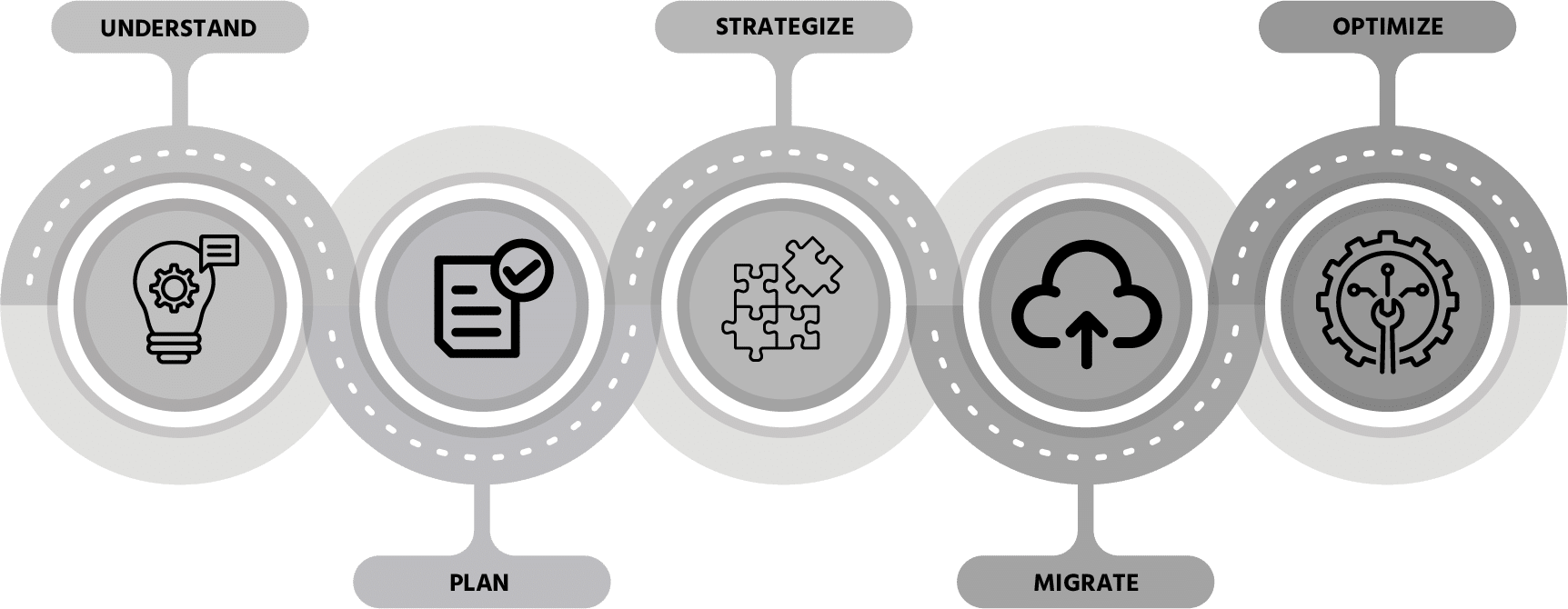In todays age, where the concept of digital transformation is not just a trendy term but a necessity for businesses, migrating to the cloud has become an essential step for companies looking to succeed in the competitive global market. Cloud Migration – the process of moving data, applications, and other business elements to a cloud computing environment – is no longer just an option; it’s a strategic move that offers unparalleled scalability, flexibility, and efficiency.
Companies of all sizes from startups to Fortune 500 giants have come to realize the power of cloud technology. Whether it’s about improving performance, enhancing security measures, or optimizing costs, the cloud presents benefits. How can your business effectively harness these advantages? What steps should you follow to ensure that your cloud migration not only succeeds, but maximizes your return on investment?
This article focuses on comprehending what exactly cloud migration entails and guides you through planning your journey of the migration process itself. Whether you are just beginning to consider migrating or you’re already in the midst of planning your move to the cloud, this roadmap aims at providing guidance through each crucial phase.
Explaining Cloud Migration
Cloud migration refers to relocating digital business operations into a cloud-based infrastructure. This involves moving data, applications, and IT processes from a legacy infrastructure or an on-premises data center to a cloud based infrastructure. It can also include transitioning from one cloud environment to another.
Advantages of Migrating to the Cloud
- Scalability: Cloud environments offer businesses the ability to scale their IT resources based on demand, ensuring flexibility and efficiency.
- Cost Effectiveness: By utilizing pay as you go pricing models businesses can reduce capital expenditure. Achieve a predictable operations cost structure.
- Enhanced Performance: Cloud providers often provide performance capabilities that are more efficient compared to on-premises solutions.
- Improved Security: Reputable cloud providers heavily invest in security measures providing protection for data and applications.
- Business Continuity: Cloud environments enhance disaster recovery capabilities. Ensure business operations under various scenarios.
- Innovation and Agility: The cloud environment promotes innovation by granting access to the technology and services enabling businesses to adapt to market changes.
Pre-Migration Planning
This phase is crucial as it establishes a foundation for a transition to the cloud. It revolves around evaluating business needs and setting goals for the cloud migration. Planning for cloud migration also includes evaluating which applications and data are suitable for the cloud. Factors such as importance, usage, compatibility, compliance, and security requirements need to be taken into consideration.
Choosing the right cloud service provider is crucial. This decision should be based on factors like service offerings, reliability, security standards and cost structures. It is also important to assess risks such as data loss or downtime and develop strategies to mitigate them.
Another important aspect is determining whether your internal IT team has the expertise for the migration. If there are gaps in skills and knowledge it may be necessary to partner with a technology expert who has a proven track record in cloud migrations. The chosen partner should offer services that align with your company’s goals and culture.
Developing a Cloud Migration Strategy
Formulating a strategic approach is key to a successful transition. The heart of this strategy lies in choosing between full, incremental, and replacement migration.
Lift and Shift Strategy
On the other hand, the full migration strategy, or “Rehosting”, involves transferring all data and applications to the cloud in one move. This approach is well suited for businesses or those with less complex IT systems. It offers a quicker transition but carries higher risk, particularly in terms of potential downtime and challenges in troubleshooting.
Incremental Migration Strategy
Commonly referred to as “Replatforming”, the incremental migration strategy entails modifying and moving applications and data to the cloud in phases. This approach allows for testing and adjustment of each element before committing, minimizing disruptions to operations. It works well for businesses with complex systems or those aiming to manage risks and allocate resources.
Replacement Strategy
Another popular strategy to cloud migration is Replacing, also known as Repurchasing. This strategy involves replacing a legacy application with a SaaS solution from a third-party vendor. While replacing often presents as the least-risk method, it comes with some disadvantages. Some of these disadvantages include loss of application and data control.
The choice of the strategy depends on factors such as the size of the business, complexity of its existing infrastructure, tolerance for risk, and availability of resources. A planned migration strategy, whether its incremental or comprehensive, lays the groundwork for a transition to the cloud.

Performing the Migration
This phase brings the planned strategy to fruition. Key areas of focus during this phase include ensuring data integrity and security, maintaining business operations, and leveraging technology partnerships.
Ensuring Data Integrity and Security
Preserving data integrity is crucial throughout the migration process. This involves employing methods for transferring data and implementing encryption measures. Regular backups and validation checks should be performed to prevent any data corruption or loss.
Maintaining Business Continuity
Minimizing disruptions to day-to-day operations is essential. This can be achieved through scheduling and contingency planning. Adopting a phased migration approach can aid in ensuring continuity.
Partnering with a Technology Expert
Having a technology partner can prove invaluable when navigating the intricacies of cloud migration. They have expertise in managing large scale data transfers ensuring the implementation of security protocols and troubleshooting any issues that may arise. Their involvement can also speed up the migration process while ensuring that best practices are followed.
Management and Optimization
Once successfully migrated to the cloud, the focus shifts to optimizing and managing the cloud environment. This stage is crucial for realizing the advantages of your investment.
After migration it is important to monitor the performance of your cloud services. This includes tracking resource usage, response times, and overall system health. Optimization involves adjusting resources based on demand to improve efficiency and reduce costs. Take advantage of cloud management tools for real time monitoring and automated adjustments.
Continuous improvement is essential in a dynamic cloud environment. Stay updated with the offerings and updates from your cloud provider. Make it a regular practice to evaluate and revise your cloud strategy in order to incorporate technologies and services that can enhance your business operations.
From the planning and strategizing to the execution and optimization, each step is crucial in ensuring an efficient transition. The advantages of migrating to the cloud such as scalability, cost efficiency, enhanced performance and heightened security are truly transformative for businesses in today’s era.
Trust the Experts
Navigating the complexities of cloud migration requires expertise and experience. This is where CSE Software comes in. With our knowledge and comprehensive approach to cloud migration, CSE is fully equipped to guide your business through every phase of this journey. Whether you’re at the stages of considering cloud migration or looking to optimize your existing cloud infrastructure, our team is here to ensure a successful transition.
Get in touch with our team today for a free consultation call regarding your needs for cloud migration. Our team of experts stands ready to offer tailored solutions that align with your business objectives, enabling you to unlock the potential of the cloud. Contact our solutions team today to take the step towards a more efficient and future ready business.
Let CSE Software be your trusted guide and partner, throughout this journey.


